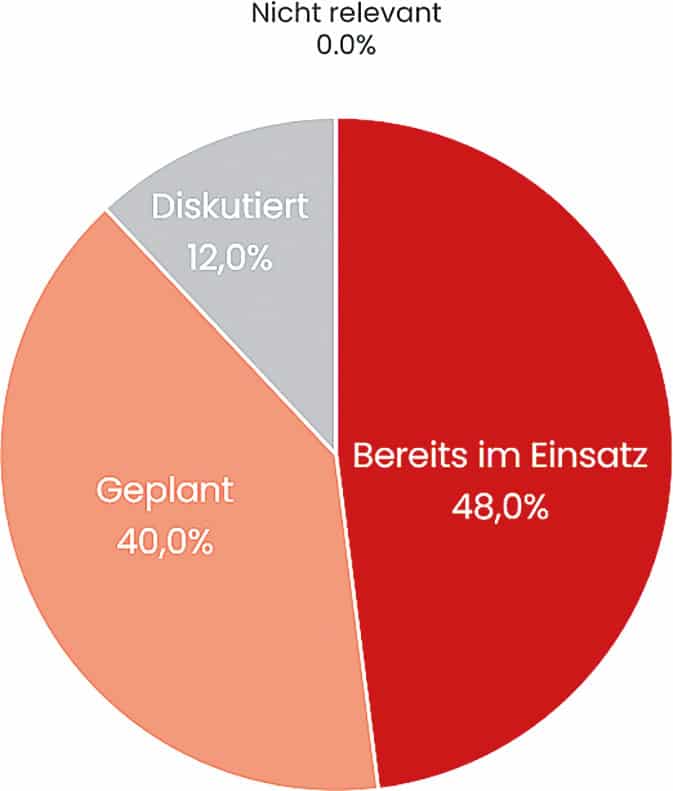

Study: Majority of midmarket companies incur SAP costs of over one million euros per year
Theobald Software's "SAP in Midsize Companies" study, in which IT decision-makers and business users were asked about their own SAP costs, is available free of charge at theobald-software.com. Almost a third of the IT decision-makers surveyed incur between 500,000 euros and one million euros annually for the SAP system, and only about one in ten companies manages with less than half a million euros. In addition to the costs for SAP itself, there are also expenses for the use of SAP data outside of SAP. This plays an important role for many companies. This can be seen from the fact that SAP-using companies are prepared to make similarly high investments for third-party applications as for SAP itself. A good two-thirds of companies invest more than 500,000 euros a year in third-party applications, and one-fifth even invest at least one million euros.
Transfer performance
These figures show: The integration of systems and data is a major concern among the IT managers surveyed. Almost two-thirds of companies transfer data from the SAP system for further processing in other systems and applications. The volume of transferred data has also risen steadily for two-thirds of the companies over the past three years. Accordingly, just under half of the participants in the study stated in the survey that they already use an integration solution, and a further 40 percent are planning to do so. No one questions the benefits of such software. The cloudification of IT landscapes also extends to the operation of integration software. Almost all respondents use the cloud option when purchasing integration software. Differences can only be seen in the mode of operation. Most (60 percent) prefer an externally hosted solution.

Use of integration software. Are you already using integration software, is this planned, is this being discussed, or is this not relevant at all? Shares of IT decision-makers surveyed. (n=75)
Maintenance, support, cloud migration
Very often, S/4 migrations involve moving to a cloud-based delivery model. This seems to be a major concern for many companies: More than 38 percent of respondents consider migrating SAP systems to the cloud a major challenge. In the past, many SAP systems were extended on a customer-specific basis, which makes maintainability difficult. It is therefore logical that over 38 percent of respondents also consider maintenance and support to be a major challenge. For about one-third, the usability as well as user-friendliness of the SAP GUI is a key aspect. Processing and analyzing SAP data: Amazon is in the lead, but competitors are hot on its heels.
Amazon's public cloud infrastructure S3 is the preferred environment for storing and processing SAP data: 59 percent use it, and another 27 percent have planned to do so. In the future, therefore, 85 percent will rely on Amazon. Likewise, 59 percent use SAP's own infrastructure, and another 19 percent have planned to do so. While MS Azure is already in use by just under half of the respondents, an additional 37 percent are planning to do so. Accordingly, the use of Microsoft will rise to a comparable level to Amazon at 87 percent.
Compared with Amazon and Microsoft Azure, Google is a latecomer to the business of public cloud solutions for B2B customers, but has already positioned itself as a serious competitor: 24 percent current use, 47 percent additionally planned. Many of the companies surveyed will specifically use MS Azure, Google Cloud Storage and Snowflake in the future. The latter is expected to record the highest growth rates. While only 13 percent currently use Snowflake, a further 44 percent will do so in the future - more than a fourfold increase. When it comes to connecting the SAP environment to cloud platforms, the picture is similar: Amazon leads, SAP's own cloud solutions are also very strong, and Microsoft - but here Power BI in particular, well ahead of Azure - follows closely behind. Snowflake as a cloud platform is also being planned by many companies.

Approximately how much does your company spend on this annually? Proportions of IT decision-makers surveyed. (n=75)
Data export and data quality
When it comes to using SAP data outside of SAP, the companies surveyed primarily have to overcome hurdles in terms of data quality. Almost half of them describe this as a major challenge. In the experience of SAP partner Theobald, data integrity and the avoidance of duplicates are of particular relevance. Security requirements also have a high priority, particularly with regard to data security and protection. When asked about the particularly relevant aspects of processing SAP data, data quality came first among the business users surveyed, with 79 percent. The high ratings for reliability and validity (60 to 71 percent each) also underscore the need for quality in the data to be processed.
Central data storage, in the sense of a single point of truth, is the most important issue for most of the companies surveyed. It makes it easier to ensure high data quality, which in turn is the basis for further data processing. Around nine out of ten respondents find central data storage very or rather important. Therefore, data lakes and data lakehouses are becoming important building blocks in the processing of SAP data: According to the study, a good 40 percent of companies are currently using corresponding solutions, and this figure will rise to 68 percent in the future.
90 percent want real time
For at least 80 percent of the participants, data transformation, modeling and consolidation are just as important as central data storage. Many of the business users surveyed also rate SAP license management as a major challenge and the high-performance retrieval of SAP data as a significant challenge. The vast majority of respondents rely on third-party providers to access SAP data or transfer SAP data for further processing in other systems. Slightly more than one-third use solutions developed in-house for this purpose.
Two-thirds of the business users surveyed then use the data intensively for reports, and almost as many also for business analyses. These are classic disciplines that ERP solutions map. About half use it just as much for controlling and forecasts. For these and possibly other purposes, almost 80 percent access SAP data several times a day.
However, two-thirds of the companies surveyed state that internal approval processes by the SAP operations team take several days or weeks, and in some cases even months. Only one-third of respondents can expect processing within one day. Almost 90 percent of the companies surveyed consider access to real-time data in SAP systems to be rather important or very important.
The business side is increasingly deciding how data is processed: According to the assessment of the vast majority of Data Scientists and Data Analysts surveyed, decisions around the processing of data are increasingly being made by the business side. Overall, 72 percent fully or somewhat agree with this. This is conclusive, since the expertise for data use is usually anchored in the business departments - not infrastructure-related decisions are meant here.
The increasingly important role of business departments in processing SAP data and using integration software is leading to a prioritization of know-how transfer. For over 90 percent of the study participants, more intensive training courses are suitable for this purpose, and well over 80 percent would like to see a less technical high-level approach and the expansion of self-service offerings.

Conclusion:
The top issues for IT decision-makers are cloud migration and the ongoing expense of maintaining and supporting SAP systems. Cloud solutions are the preferred mode of operation for both SAP systems and integration software. There is a widespread need to use and process SAP data outside of SAP systems. Demand for integration software is correspondingly pronounced. Just under half of the respondents are already using such a solution, and another 40 percent are planning to purchase it. It is clear that the larger proportion is relying on third-party solutions from software manufacturers and less on solutions developed in-house. Overall, the survey confirms the trend toward more intensive use and processing of data in general, as well as the transfer of SAP data to external systems for simpler and cheaper data processing. SAP data is mainly used for reporting, business analyses, controlling and forecasting.
This shows that it is precisely the corresponding specialist departments that have a need for SAP data. An important requirement of the business users is central data storage (single point of truth), which is fulfilled by the installation of data lakes and data warehouses. They are currently being used intensively or will be in the future. The big players such as Amazon, Microsoft, Snowflake and Google are particularly strong in this respect. SAP data is accessed several times a day by almost 80 percent of the companies surveyed, and access to real-time data is essential for almost all of them. In addition, high quality plays a decisive role. Security is also a key issue and is seen as a particularly big challenge by business users.
The internal approval process by the SAP Basis team takes at least several days at two-thirds of the companies surveyed, but also weeks and months in some cases. The market research institute commissioned by Theobald Software surveyed 150 IT decision-makers and business users from the DACH region in the fourth quarter of last year. At the time of the survey, these were employed in medium-sized companies that used SAP and were equally divided between three sectors: Services, Trade and Transportation; Manufacturing or Production; and Public Sector. Theobald Software's "SAP in the Midmarket" study is available free of charge for downloading. Download ready






